To connect insights quickly with mind mapping, start by setting clear objectives to focus your efforts. Gather accurate data, then organize key ideas into categories using colors, symbols, and visual cues to enhance clarity. Recognize patterns, relationships, and overlaps to reveal underlying themes. Prioritize the most impactful insights for decision-making, then refine your map for maximum clarity. Continuing will help you master techniques that make your synthesis faster and more effective.
Key Takeaways
- Use visual diagrams with central ideas and branches to quickly organize and connect related insights.
- Incorporate colors, symbols, and images to enhance clarity and facilitate rapid pattern recognition.
- Define clear objectives and relevant data beforehand to focus the mapping process on meaningful connections.
- Recognize recurring themes and relationships to synthesize complex information efficiently.
- Prioritize key insights using visual ranking and highlight core themes for swift understanding and integration.
Understanding the Foundations of Mind Mapping
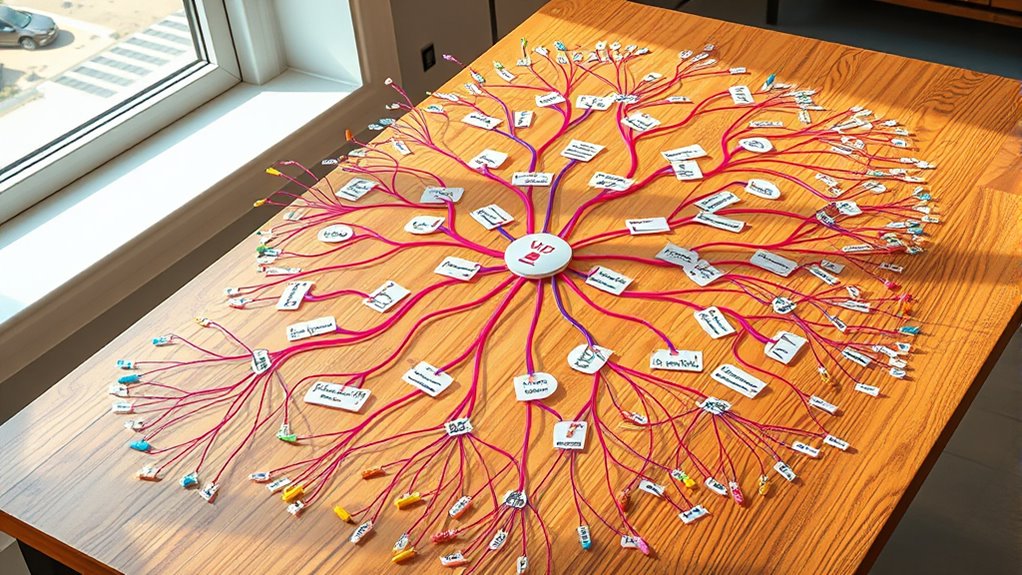
Have you ever wondered how to organize complex ideas quickly and effectively? That’s where understanding the foundations of mind mapping comes in. It’s a powerful tool that leverages brainstorming techniques to generate ideas rapidly. By using mental visualization, you can see connections and relationships between concepts clearly, making it easier to structure information. Mind mapping transforms abstract thoughts into visual diagrams, with a central idea at the core and branches extending outward. This approach taps into your brain’s natural way of processing information, enhancing memory and creativity. When you grasp these basic principles, you’ll be able to create clear, interconnected maps that simplify complex topics and help synthesize multiple insights efficiently. Additionally, integrating concepts like sound healing science can deepen your understanding of how different ideas interconnect and influence one another.
Setting Clear Objectives for Your Synthesis

Building on your understanding of mind mapping’s foundational principles, the next step is to define clear objectives for your synthesis. Effective goal setting guarantees you stay focused and avoid distraction. When setting objectives, ask yourself what insights you want to connect and what outcomes you aim to achieve. Clear objectives guide your mind map’s structure, making it easier to identify relevant information and avoid unnecessary details. This clarity enhancement helps streamline your thinking process, enabling faster synthesis. Remember, specific goals prevent you from drifting off-topic and keep your mind mapping disciplined. By establishing precise objectives early, you create a roadmap that accelerates insight connection and makes record time synthesis achievable. Nike Tech innovations exemplify how setting clear goals can drive focused creative efforts.
Gathering and Organizing Your Core Data
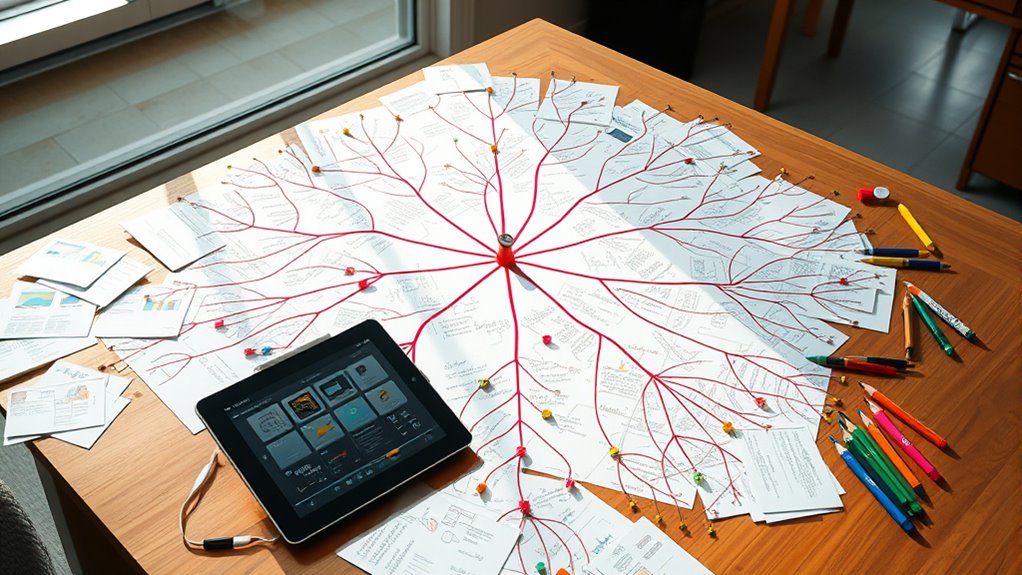
To create an effective mind map, start by gathering your core data from reliable sources and organizing it logically. Focus on efficient data collection, ensuring your information is accurate and relevant. As you gather data, categorize your ideas into clear groups, making it easier to see connections later. Use idea categorization to group similar concepts, themes, or insights, which helps streamline the synthesis process. Keep your data organized in a way that highlights relationships and patterns, avoiding clutter. This step sets the foundation for a meaningful and interconnected mind map. Incorporating essential gear for preppers such as water purification systems and first aid kits can help you identify key survival priorities. When your core data is well-organized, you’ll find it much easier to identify key insights and develop a cohesive overview of your topic.
Creating a Visual Framework for Connections

Creating a visual framework helps you organize ideas clearly and see how they relate to each other. It boosts your memory recall by making connections more memorable. By highlighting key relationships, you can better understand and synthesize complex information. Incorporating beneficial ingredients like collagen and hyaluronic acid into eye patches can further enhance their effectiveness.
Organizing Ideas Visually
Have you ever struggled to organize complex ideas in a way that makes sense at a glance? That’s where visual frameworks come in, helping you see connections effortlessly. By using mind maps, you turn abstract thoughts into an artistic visualization, making your ideas more accessible and engaging. This approach encourages creative expression, allowing you to arrange concepts with color, images, and symbols that resonate personally. When you organize ideas visually, you create a clear structure that highlights relationships and hierarchies, making it easier to analyze and synthesize information quickly. The visual layout acts as a map, guiding your thinking and inspiring new insights. Incorporating design principles into your visualizations can further enhance clarity and impact. With this method, you transform chaos into clarity, access your ability to connect ideas rapidly and effectively.
Enhancing Memory Recall
Ever wonder why some information sticks in your mind better than others? Creating a visual framework with mind maps helps boost your memory recall. By organizing ideas visually, you engage your brain more actively, making connections clearer. Incorporate mnemonic techniques within your mind map to encode information more effectively—using images, acronyms, or associations. Spaced repetition further solidifies your memory; revisit your mind maps at intervals to reinforce learning. This combination strengthens neural pathways, making it easier to retrieve information quickly. As you build these visual frameworks, you’re not just passively reading or listening—you’re actively embedding knowledge into your memory. With consistent practice, these strategies turn complex data into memorable, interconnected images, helping you recall details effortlessly when you need them most. Additionally, integrating visual learning tools like diagrams or charts can enhance the effectiveness of your mind maps by providing clearer, more memorable representations of information.
Identifying Key Relationships
To effectively understand complex information, you need to identify the key relationships that connect ideas within your mind map. This process, known as relationship mapping, helps you see how concepts interlink, fostering conceptual clarity. By pinpointing these connections, you transform a scattered collection of ideas into a coherent visual framework. Focus on relationships such as cause-and-effect, hierarchy, or similarity, and use lines or arrows to illustrate these links clearly. This not only simplifies complex topics but also reveals underlying patterns or gaps. As you build your mind map, actively seek out these relationships, ensuring each connection enhances your understanding. Recognizing the importance of conceptual relationships can significantly improve your ability to synthesize information effectively. The result is a structured, insightful map that accelerates synthesis and deepens your grasp of the subject matter.
Identifying Patterns and Relationships

How can you effectively uncover underlying connections within complex information? The key lies in pattern recognition and relationship mapping. As you create your mind map, look for recurring themes, similarities, or sequences that reveal how ideas connect. Spotting patterns helps you see trends or commonalities that might not be immediately obvious. Relationship mapping allows you to trace how different concepts influence or relate to each other, highlighting causes and effects or hierarchies. By actively analyzing these connections, you simplify complexity and gain a clearer understanding of the bigger picture. This process transforms scattered data into organized insights, enabling you to synthesize information faster and more effectively. Recognizing patterns and relationships is essential for deep comprehension and strategic decision-making. Additionally, understanding the cost considerations associated with security systems can help you prioritize investments effectively.
Using Color and Symbols to Enhance Clarity
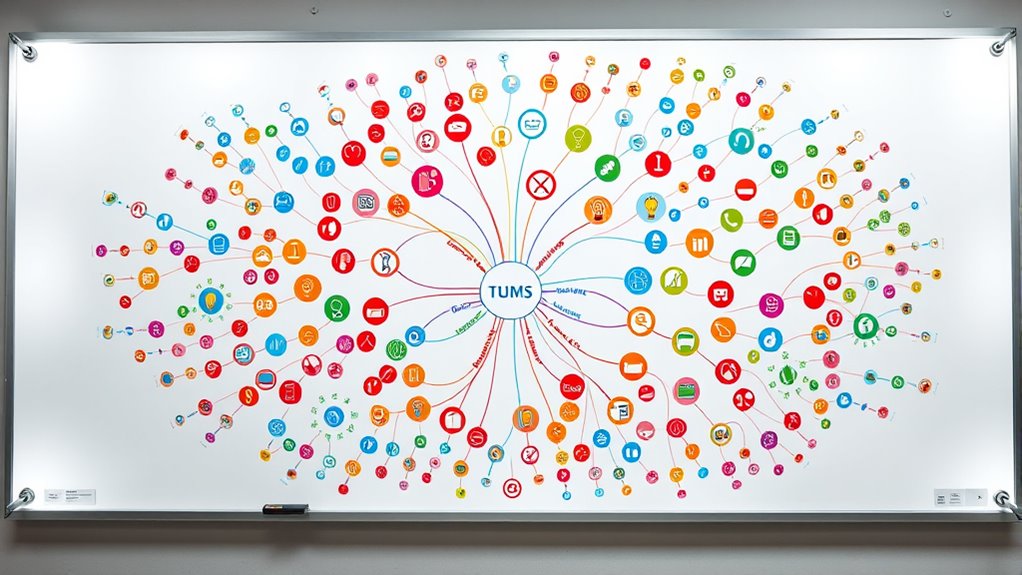
Using color coding and symbols can make your mind maps much easier to interpret at a glance. They help you distinguish ideas quickly and highlight important connections. By applying strategic color and symbolic notation, you boost visual clarity and improve overall understanding. Incorporating best anime movies into your mind map can also provide culturally enriching references that resonate deeply with viewers.
Color Coding Strategies
Color coding strategies can substantially improve the clarity of your mind maps by helping you quickly identify and differentiate key ideas. By using color differentiation, you assign specific hues to categories or themes, making connections instantly visible. For example, green might represent growth or ideas related to progress, while red indicates challenges or risks. Hue symbolism taps into psychological associations, reinforcing meaning through color choices. Consistent color use allows you to scan your map and grasp relationships without confusion. Additionally, limiting your palette to a few distinct colors prevents overload and maintains focus. Thoughtful application of color coding turns a cluttered map into a visual powerhouse, streamlining comprehension and boosting your ability to synthesize insights effectively. Incorporating visual cues like symbols alongside colors can further enhance memory retention and quick recognition.
Symbolic Notation Benefits
Incorporating symbols alongside color coding amplifies the clarity of your mind maps by providing visual shorthand that quickly communicates complex ideas. Abstract symbolism allows you to represent concepts with simple, recognizable icons, reducing clutter and making connections more intuitive. This approach boosts notation efficiency, enabling you to encode information rapidly without lengthy explanations. Symbols can denote relationships, processes, or categories, helping you differentiate ideas at a glance. When combined with color, symbols create a layered system that enhances understanding and recall. Using consistent symbols streamlines your workflow, allowing you to focus on synthesis rather than deciphering meaning. This strategic use of abstract symbolism transforms your mind maps into powerful tools for quick insight and deeper comprehension.
Visual Clarity Enhancement
Enhancing visual clarity in your mind maps hinges on combining the strategic use of color and symbols to distinguish ideas effectively. By applying a clear visual hierarchy, you guide the eye through key concepts and their relationships, making complex information easier to process. Use color to categorize related ideas, emphasizing importance or different themes, which helps your brain quickly identify connections. Incorporate iconography techniques—simple symbols and icons—to represent ideas efficiently, reducing clutter and enhancing comprehension. Consistent use of color and symbols creates a cohesive, intuitive map that highlights priorities and simplifies navigation. This approach ensures your mind map remains clear and organized, allowing you to synthesize insights rapidly and retain information effortlessly.
Integrating Multiple Perspectives Seamlessly
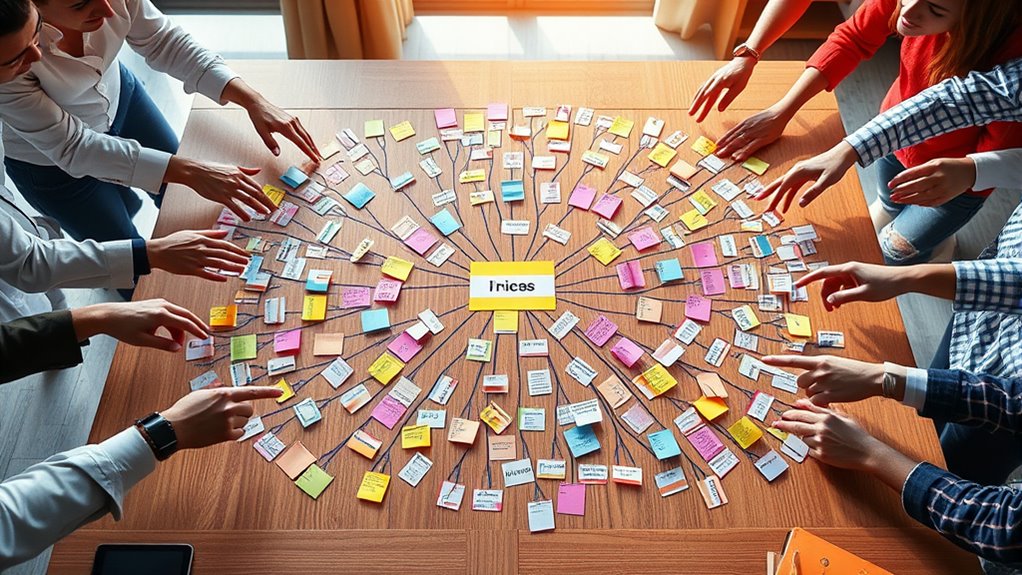
To integrate multiple perspectives seamlessly, you need to establish clear connections between different ideas and viewpoints. Focus on perspective integration by mapping how each insight relates to others, revealing common themes or contradictions. Use your mind map to visualize cross-disciplinary synthesis, blending ideas from various fields to create a holistic understanding. As you connect diverse perspectives, look for patterns or overlaps that can bridge gaps between disciplines. This approach allows you to see the bigger picture, highlighting how different insights complement or challenge each other. Keep your connections explicit and logical, ensuring that each perspective supports your overall synthesis. With practice, your mind map becomes a dynamic tool that effortlessly combines multiple viewpoints, accelerating your ability to synthesize complex information swiftly and effectively.
Prioritizing Insights for Effective Decision-Making

Prioritizing insights is essential for making effective decisions amidst a flood of information. To do this, focus on quick evaluation—identify which insights align with your goals and have the most significant impact. Efficient time management helps you sift through data swiftly, avoiding analysis paralysis. Engage stakeholders early to understand their priorities and clarify which insights matter most to them. This collaboration ensures you’re not wasting time on less relevant details and that key perspectives are considered. Use your mind map to visually rank insights based on urgency, relevance, and potential influence. By systematically prioritizing, you streamline decision-making, making it more targeted and effective. Remember, clear priorities enable you to act confidently, saving time and fostering stakeholder confidence in your choices.
Refining Your Map for Maximum Impact

To make your mind map more impactful, focus on highlighting key connections that reveal underlying relationships. Simplify complex ideas to guarantee your map remains clear and easy to follow. Prioritize core themes to keep your map focused and maximize its ability to inform your decisions.
Highlight Key Connections
Highlighting key connections is essential for sharpening your mind map and making it more impactful. By identifying and emphasizing relationships between ideas, you enhance your conceptual flexibility, allowing you to see patterns and insights that might otherwise remain hidden. Focus on how different concepts relate, overlap, or influence each other, fostering creative exploration. This process helps you prioritize the most significant links, making your map more organized and purposeful. When you highlight these connections, you’re not just adding details—you’re clarifying the structure of your thinking. This clarity enables you to synthesize ideas more efficiently and stimulates innovative insights. Ultimately, emphasizing key connections transforms your map from a collection of ideas into a powerful tool for understanding and discovery.
Simplify Complex Ideas
When your mind map becomes cluttered with complex ideas, the key to maximum impact is simplifying them without losing essential meaning. Focus on concept simplification by breaking down complicated thoughts into clear, digestible components. Use idea distillation to strip away unnecessary details, leaving only the core message. This process helps you see connections more easily and prevents overwhelm. To refine your map, identify the main idea and eliminate tangents or redundancies. Summarize complex points with simple language, ensuring each element serves a purpose. By distilling ideas this way, your map becomes more focused, empowering you to connect insights faster and more effectively. Simplification isn’t about oversimplifying, but about clarifying to *unblock* the full potential of your insights.
Prioritize Core Themes
Ever wondered how to make your mind map truly impactful? Prioritizing core themes helps you focus on what truly matters, ensuring your insights resonate. By identifying the key ideas that drive your narrative, you create a framework for creative storytelling that captures attention. Highlight these themes visually, using bold lines or colors, to enhance emotional engagement. This refinement prevents distractions, streamlines your map, and guides your audience through your insights seamlessly. When you concentrate on core themes, every connection you make amplifies their significance, making your synthesis more compelling. Remember, a well-prioritized map tells a clear story, engages emotions, and leaves a lasting impression—all in record time.
Applying Your Map to Real-World Challenges
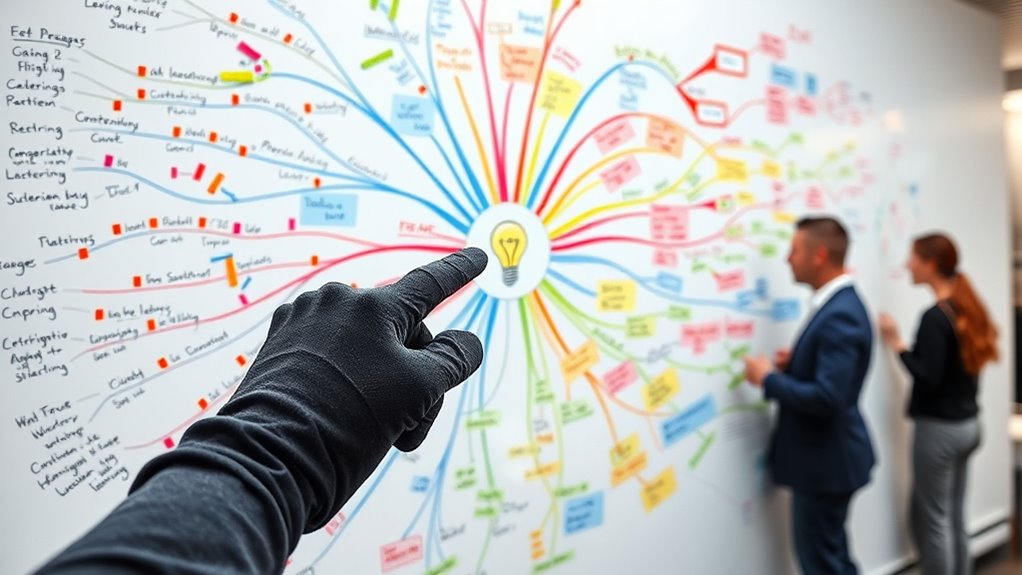
How can you turn your mind map into a practical tool for solving real-world challenges? Start by examining case studies that relate to your situation. These examples show how others applied similar maps to address specific problems, revealing practical applications you can adapt. Use your map to break down complex issues into manageable parts, identify key connections, and develop targeted solutions. Incorporate insights from case studies to refine your approach and anticipate potential obstacles. By visualizing options and strategies within your map, you create a clear action plan. This method not only streamlines decision-making but also boosts confidence in tackling challenges efficiently, making your mind map a powerful, real-world problem-solving tool.
Frequently Asked Questions
How Can I Adapt Mind Mapping for Complex, Multi-Layered Information?
When tackling complex, multi-layered information, you can adapt mind mapping by emphasizing hierarchical structuring. Break down main ideas into subtopics and further into detailed points, creating clear layers. Use visual layering techniques like color coding, shading, or varying line thickness to distinguish levels. This approach helps you see connections and manage complexity, making it easier to synthesize insights efficiently and retain the overall picture without feeling overwhelmed.
What Tools or Software Best Support Dynamic Mind Mapping?
Thinking of your mind map as a living tree, you’ll want tools that grow with you. Digital tools like XMind, MindMeister, and Coggle offer dynamic features to support your ideas. Collaboration platforms such as Miro and Microsoft Whiteboard make it easy to work with others in real-time. These options empower you to create, expand, and connect insights seamlessly, turning complex information into a beautiful, interconnected web.
How Do I Ensure My Mind Map Remains Flexible Over Time?
To keep your mind map flexible over time, focus on ongoing revision and adaptable structure. Regularly update your map as new insights emerge, and avoid rigid layouts that restrict growth. Use tools that support easy editing and restructuring, so you can modify connections effortlessly. By maintaining a flexible structure, you’ll ensure your mind map stays relevant and useful, helping you connect insights quickly and efficiently as your understanding evolves.
Can Mind Mapping Help Improve Team Collaboration and Communication?
Imagine you’re in a time before the internet, trying to coordinate a quest like in medieval times. Mind mapping boosts team collaboration and communication by visually organizing ideas, fostering shared understanding. It encourages collaborative strategies, making everyone’s input clear and accessible. This method enhances communication, helps identify gaps, and aligns goals quickly, turning complex projects into manageable tasks. So, yes, mind mapping is a powerful tool for effective team synergy.
How Do I Measure the Effectiveness of My Mind Map in Decision-Making?
To measure your mind map’s effectiveness in decision-making, focus on quantitative metrics like decision accuracy, speed, and outcome improvements. Use feedback methods such as surveys or interviews to gather insights from users about clarity and usefulness. Track how quickly you reach decisions and whether those decisions lead to desired results. Combining these metrics and feedback helps you evaluate if your mind map truly enhances your decision-making process.
Conclusion
By mastering mind mapping, you streamline synthesis, sparking swift, strategic success. Connect core concepts, create clarity, and cultivate confidence with each connection. As you refine and relate insights, your understanding deepens, delivering decisive decisions and dynamic development. Embrace this method’s magic to maximize mastery, multiply meaningful milestones, and make your mark with minimal muddle. With mindful mapping, your mind’s might moves mountains in record time.









